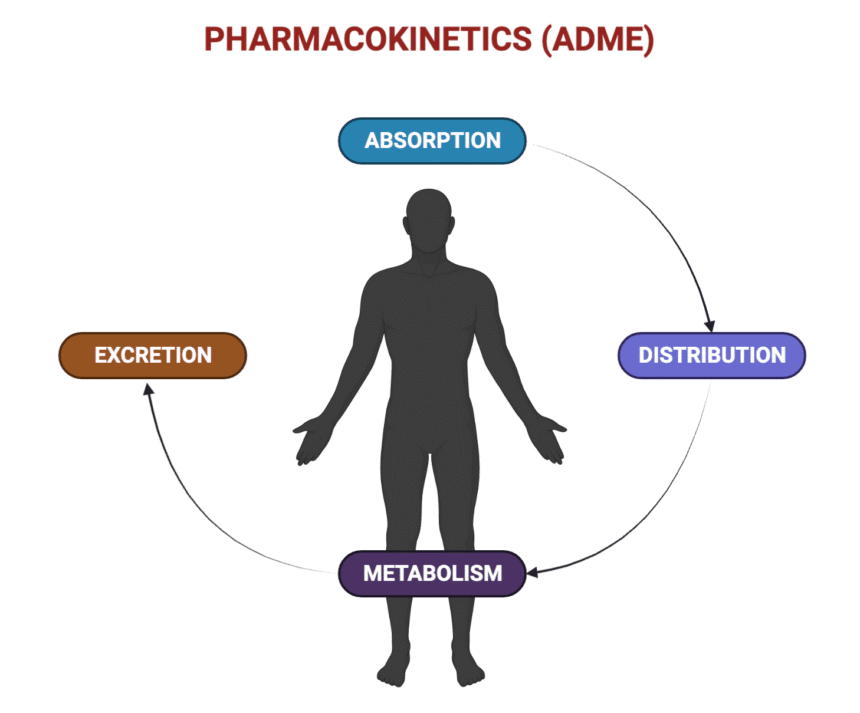Introduction
Pharmacokinetics is the science that describes how drugs move within the body and is crucial for rational dosing in clinical settings. This article aims to provide a comprehensive understanding of the key pharmacokinetic principles, including the movement of drugs in the body, permeation, Fick’s Law of Diffusion, and the solubility characteristics of drugs.
The Movement of Drugs in the Body
For a drug to exert its therapeutic effects, it must be absorbed, distributed, and eventually eliminated. The drug molecule must travel from its site of administration, such as the gastrointestinal tract, to its site of action, like the brain, to interact with its receptors and produce a biological effect.
Permeation
Permeation refers to the movement of drug molecules into and within the biological environment. It involves several processes:
1. Aqueous Diffusion
This is the passive movement of molecules through watery extracellular and intracellular spaces. It is governed by Fick’s Law and occurs mainly through small water-filled pores in most capillary membranes. However, some organs like the brain and testes lack these aqueous pores, making them less exposed to certain drugs.
2. Lipid Diffusion
This is also a passive process where molecules move through lipid barriers like cell membranes. It is also governed by Fick’s Law.
3. Transport by Special Carriers
Some drugs that do not readily diffuse may be transported by special carrier mechanisms. These carriers often transport endogenous substances like ions, neurotransmitters, and metabolites. This process is not governed by Fick’s Law and is capacity-limited.
4. Endocytosis and Exocytosis
Endocytosis allows very large or lipid-insoluble molecules to enter cells by binding to specialized receptors on cell membranes. Exocytosis is the reverse process, where substances are expelled from the cell.
Fick’s Law of Diffusion
Fick’s Law predicts the rate of molecular movement across a barrier. The equation is:
\text{Rate} = (C_1 - C_2) \times \frac{\text{Permeability coefficient} \times \text{Area}}{\text{Thickness}}Where:
- C1 and C2 are the concentrations on either side of the barrier.
- Permeability coefficient is a constant that depends on the medium and the substance being diffused.
- Area is the surface area of the barrier.
- Thickness is the thickness of the barrier.
This law is crucial for understanding how quickly a drug will be absorbed in different organs based on their surface area and membrane thickness.
Solubility of Drugs
1. Water and Lipid Solubility
The solubility of a drug is often determined by its electrostatic charge. Water-soluble drugs are usually charged (ionized), while lipid-soluble drugs are generally uncharged (non-ionized).
2. Ionization of Weak Acids and Bases
The ionization state of weak acids and bases is influenced by the pH of the medium. The Henderson-Hasselbalch equation can predict the fraction of ionized vs. non-ionized molecules.
Ionization State
Ionization State on Drug Absorption
The ionization state of a drug affects its solubility and, consequently, its absorption and distribution. Weak acids are better absorbed in acidic environments where they are primarily in their non-ionized form. Conversely, weak bases are better absorbed in alkaline environments.
Ionization State on Drug Distribution
The ionization state also affects how a drug is distributed in various body compartments. For example, ionized forms of drugs do not readily cross cell membranes, affecting their distribution.
Ionization State on Drug Elimination
The ionization state can affect how quickly a drug is eliminated from the body. For example, making the urine more alkaline can promote the excretion of weak acids.
Clinical Implications
Understanding these principles is vital for predicting how drugs will behave in different physiological environments. For example, the rate of drug excretion can be influenced by the pH of the urine. Alkaline urine speeds up the excretion of weak acid drugs like aspirin, while acidic urine does the same for weak base drugs like amphetamines.
Conclusion
Pharmacokinetic principles are essential for the rational prescribing of drugs. They help in understanding how drugs are absorbed, distributed, and eliminated from the body, thereby aiding in effective and safe medical treatment.
Bibliography:
Katzung & Trevor’s Pharmacology: Examination & Board Review, 10e Trevor AJ, Katzung BG, Kruidering-Hall MM, Masters SB. Trevor A.J., & Katzung B.G., & Kruidering-Hall M.M., & Masters S.B.(Eds.),Eds. Anthony J. Trevor, et al.
For detailed notes on pharmacokinetics, visit below page:
Quiz on Pharmacokinetics and Pharmacodynamics
📚 AI Pharma Quiz Generator
🎉 Quiz Results
Medical Disclaimer
The medical information on this post is for general educational purposes only and is provided by Pharmacology Mentor. While we strive to keep content current and accurate, Pharmacology Mentor makes no representations or warranties, express or implied, regarding the completeness, accuracy, reliability, suitability, or availability of the post, the website, or any information, products, services, or related graphics for any purpose. This content is not a substitute for professional medical advice, diagnosis, or treatment; always seek the advice of your physician or other qualified health provider with any questions you may have regarding a medical condition and never disregard or delay seeking professional advice because of something you have read here. Reliance on any information provided is solely at your own risk.









